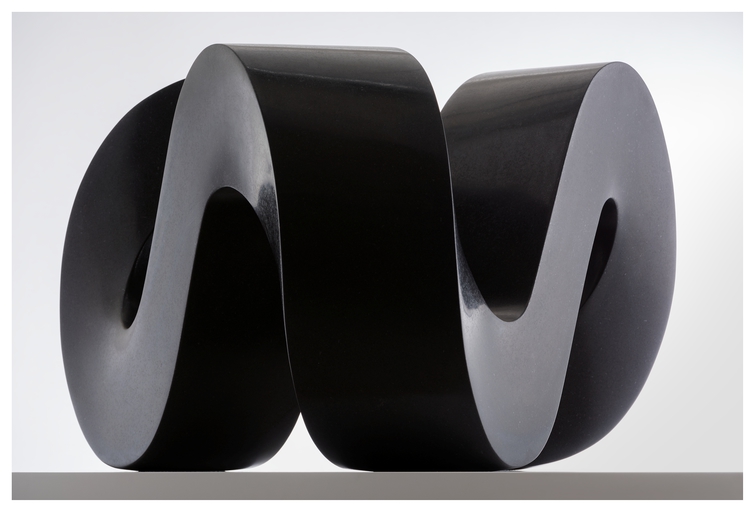HJ: Let me begin by being very honest: publicly discussing Norwegian artists makes me nervous. There is a wealth of art historical, social and political contexts that, as a relative newcomer, I have to admit that don’t fully have in my grasp. So when I was excitingly informed by a colleague about an upcoming exhibition with one of her favorite artists, Aase Texmon Rygh, I was forced yet again to hide my cringe of embarrassment. As an American now living and working in Norway, I’ve been faced countless times with the phrase “the very famous [important, formative, well-known, fill in the blank] Norwegian artist [famous artist’s name].” It’s a practice in humility. I have to own up to never having heard of this artist before, and instead turn shame over my ignorance about artists in the region into excitement about the opportunity to discover and delve into the work yet another artist with which I have not formerly been acquainted.
Naturally before the opening, I attempted to research the artist online. Other than a relatively few cursory biographies and a selection of images on Google, I was able to dig up very little substantial information about the artist’s work, life, and creative ethos in English. Thus it was both a curse and a blessing that I was able to approach the current exhibition of Aase Texmon Rygh’s sculptures at Sølvberget Galleri with an almost-completely clean slate.
AHW: I first encountered Aase Texmon Rygh’s work years before at the University of Oslo, Blindern. As an Art History student, my attention was drawn to her sculpture outside of the Niels Treschows house. It was interesting to see that students often sat on it, or used it as an obvious meeting place. Later on, I saw the sculpture Mobius Standing outside of Stavanger Kunstmuseum by Mosvannet, and at dOCUMENTA (13) in Kassel, Germany. Here we could see six smaller sculptures presented in a low, but large pedestal. Two of the sculptures were variations of Möbius band, Pirouette (1951) and Sleep (1954). The others were organic shapes made in wood. That said, I was excited to experience a solo exhibition of her work at Sølvberget Galleri. But Heather, coming to the exhibition with clean slate, how would you describe your first meeting with her work?
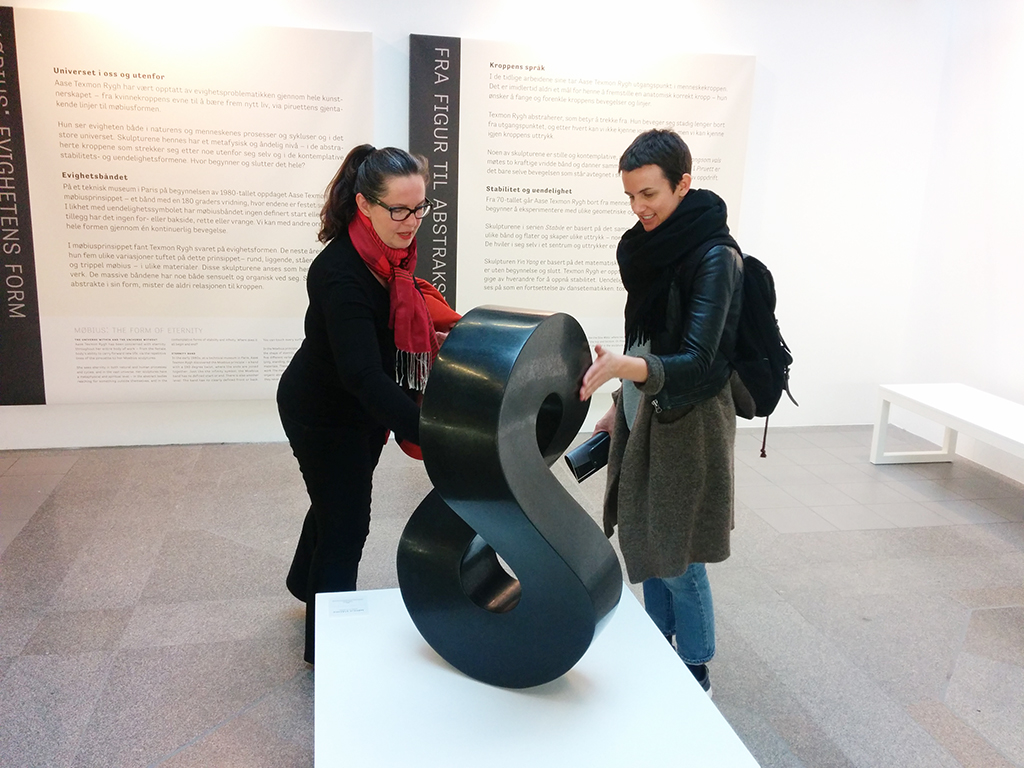
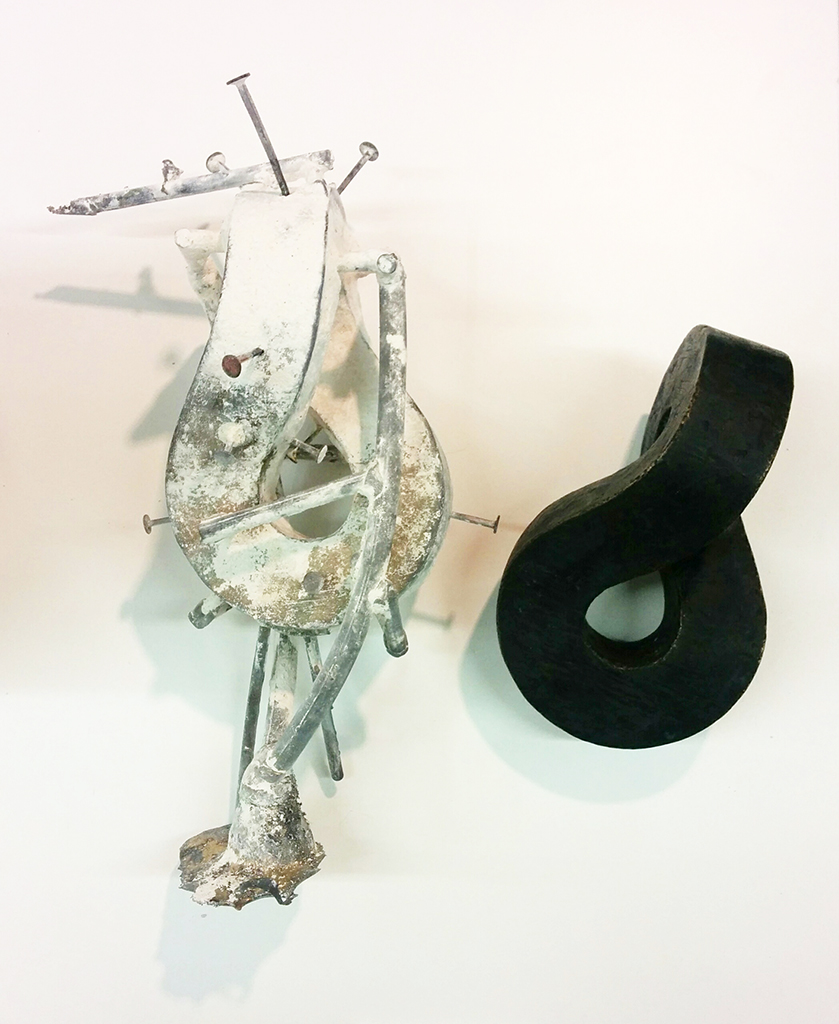
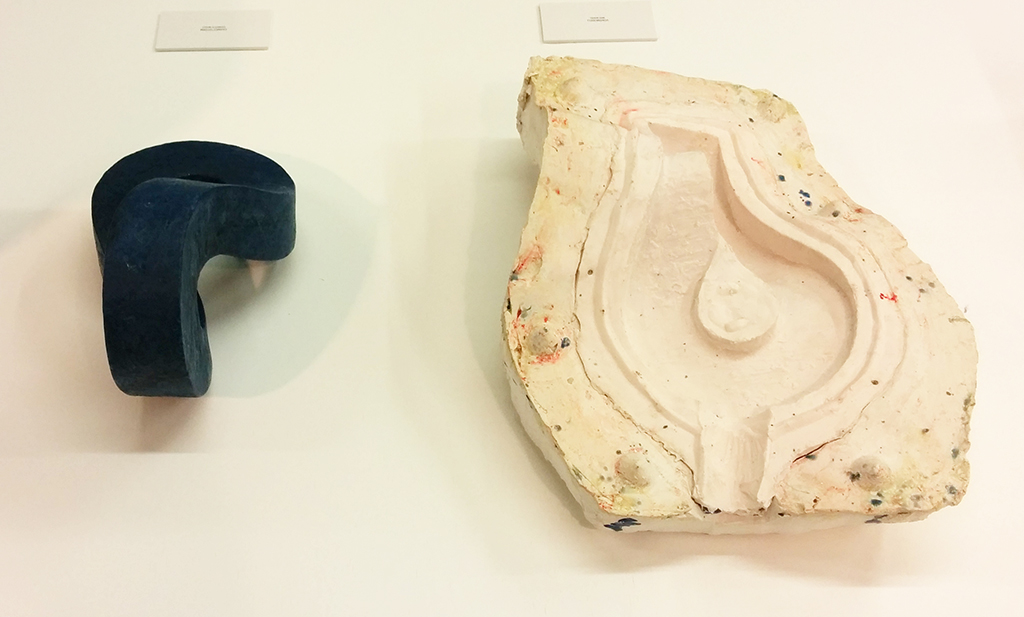
HJ: The first thing that struck me was the weight of the sculptures. By this I don’t mean weight in physical terms (although they certainly appear heavy), but in their substantial presence in the room. This feeling was quickly followed by their elegance; their seamless curves and perfectly smooth edges. Their polished surfaces, their seductiveness. In short, these sculptures beg to be touched. I was thrilled to learn, later during the opening, that visitors were welcome to touch the larger, uncovered sculptures. It seems the natural thing to do – to understand a three-dimensional sculpture haptically rather than solely by sight. This view was also held by Barbara Hepworth who, though older, was working at the same time as Texmon Rygh.
Several videos of and about the artist provided movement and additional information to the exhibition, although as they were in Norwegian, less helpful to me. I was most drawn in, after a close look at the artworks themselves, to an extensive timeline in vinyl that stretched around the gallery walls. It was here that I learned that Texmon Rygh was born in 1925 in Dyrøy, Norway. She attended the Norwegian National Academy of Craft and Art Industry from 1944-1946 and the Academy of Art in Copenhagen from 1948-49. And perhaps most notably, it was Texmon Rygh who, at 27 years of age, was the first to introduce abstract sculpture to the Norwegian public, or so says the didactic information. Unfortunately it stops there, and doesn’t elaborate this claim in more detail…
AHW: Interestingly, it was about this time in her life that she stated in an interview in Aftenposten that “I was young and unsecure, was late to mature and not always well-adjusted in social situations.” Texmon Rygh was the first Norwegian abstract sculptor after the war, but was not recognised as a member of Norsk Billedhoggerforeing (NBF), she was not member of the Unge Kunstneres Samfund (UKS), and very few collectors or institutions supported her art. Her first exhibition was in 1950 at the Høstutstillingen in Oslo, but she was not granted membership into the Norwegian Sculptors Association (NBF) until 1963. Abstract art as a movement gradually came to Norway from the mid 1900’s, but the focus was heavily on painting. In addition, the art community in Norway (as much of the rest of the world) was dominated by men, both in art institutions, among critics, curators and artists. Aase Texmon Rygh was virtually alone working on an abstract expression in Norwegian art in the 1950s. Rather Arnold Haukeland was often recognised as the first Norwegian modernist. He had been to Venezia-biennalen in 1960 and ’discovered’ abstract forms. The Norwegian art historian Gunnar Danbolt writes in his book Norsk kunsthistorie, bilde og skulptur fra vikingtida til i dag that Texmon Rygh was the first to comment, already in 1952, on the central modernist tenet that art is not only imitation, but also form.
HJ: It’s interesting then, that her work is now being recognized late in her life, along with so many other women artists. Presented in both Norwegian and English, the gallery’s timeline provided not only basic biographical information about Texmon Rygh, but also about her contemporaries in modernist sculpture such as Henry Moore and Barbara Hepworth, and even suggestions about when and where she would have come into contact with them either personally or through exhibitions of their artwork. This not only sheds light onto her practice and influences, but firmly inserts the work of this (until recently) under-recognized Norwegian artist directly into the timeline and narrative of Modernism, where it belongs: central and fully integrated rather than peripheral.
AHW: Remember our talk at the café before the opening of the Aase Texmon Rygh exhibition. I mentioned that it’s a trend in Norway today, to give attention to women artists who were not recognized for their work during their time. Women like Sidsel Paaske, Elisabeth Haarr, Siri Anker Aurdal and Inger Bruun. Many of these artists were represented in the traveling exhibition Hold stenhårdt fast på greia di, curated by Eline Mugaas og Elise Storsveen that was on view at Kunsthall Stavanger in 2014. Texmon Rygh is one such woman artist who did not receive ample recognition in the beginning of her career. You commented on this as a phenomenon not just within Norway, but internationally. How do you see it from an international perspective? This is interesting because I know that Texmon Rygh often had more in common with international artists than the Norwegian artists who were more focused on figurative and naturalist sculpture and painting.
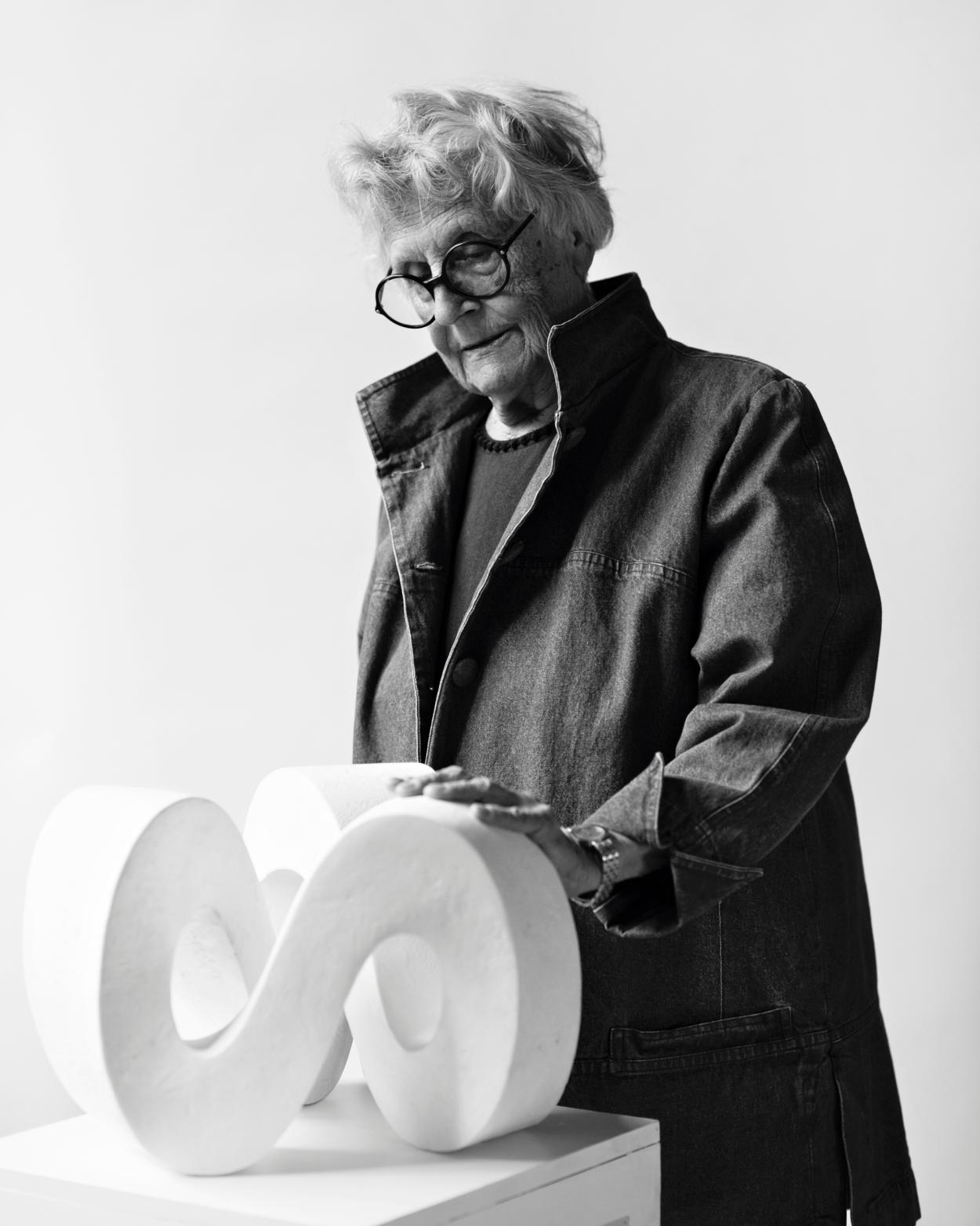
HJ: Right! Judith Bernstein immediately comes to mind as a perfect example. Largely ignored throughout her prolific career, she has only within the last decade begun to be recognized as an important and unique voice in the American and Feminist art post 1960. When asked about the recent interest in her work, she humorously but seriously said “the art world loves old women!” Of course Bernstein (born in 1942) is a generation below Texmon Rygh, but this trend of ”discovering” little known women artists extends beyond any specific genre, be it artistic movement, time period or media.
Of course there are widely recognized female artists across the board, and it’s a continuum – some are more or less well-known than others, but there are many who have yet to become household names. From MoMA to Tate to Moderna Museet and beyond, we’ve seen recent exhibitions including a wide range artists such as Hilma af Klint, Sturtevant, Lygia Clark, Elaine de Kooning, Jay DeFeo, Joan Mitchell, Nasreen Mohamedi, Carmen Herrera, Agnes Martin of course…. And thankfully in this same vein, institutions have also been turning attention female artists of color like Howardena Pindell and Lorraine O’Grady. At the Kunsthall, where I work as a curator and Exhibitions Manager, we’re currently working on an upcoming exhibition of work by the Austrian artist Kiki Kogelnik…the list goes on an on. Everything from Abstract Expressionism to Modernism to Minimalism to Pop Art and beyond.
Returning to Texmon Rygh and the works on display at Sølvberget, the exhibition focuses mainly around her major works: the so-called Mobius Sculptures. According the the exhibition text, she discovered the mathematical mobius principle in the Technical Museum in Paris in the 1980s. A ribbon twisted 180 percent before the ends are attached, provides a form without front or back, inside or outside, beginning or end. Working with this concept over the course of decades, Texmon Rygh has created five variations on this principle: round, standing, lying, double and triple, and has created major works in a variety of sculptural materials. This exhibition includes a sampling of all five variations dotting the gallery on white pedestals, as well as a series of smaller works in glass cases, cast in metal, and even the plaster moulds of some of the forms which gives further insight into the creative process of the artist.
AHW: I was happy to see her casting molds include in the exhibition. Do you have any additional thoughts or critical comments on the curatorial part of the exhibition? Would be interesting to hear your thoughts as a curator.
”If you want to enjoy my work, you must give yourself time.”
–Aase Texmon Rygh
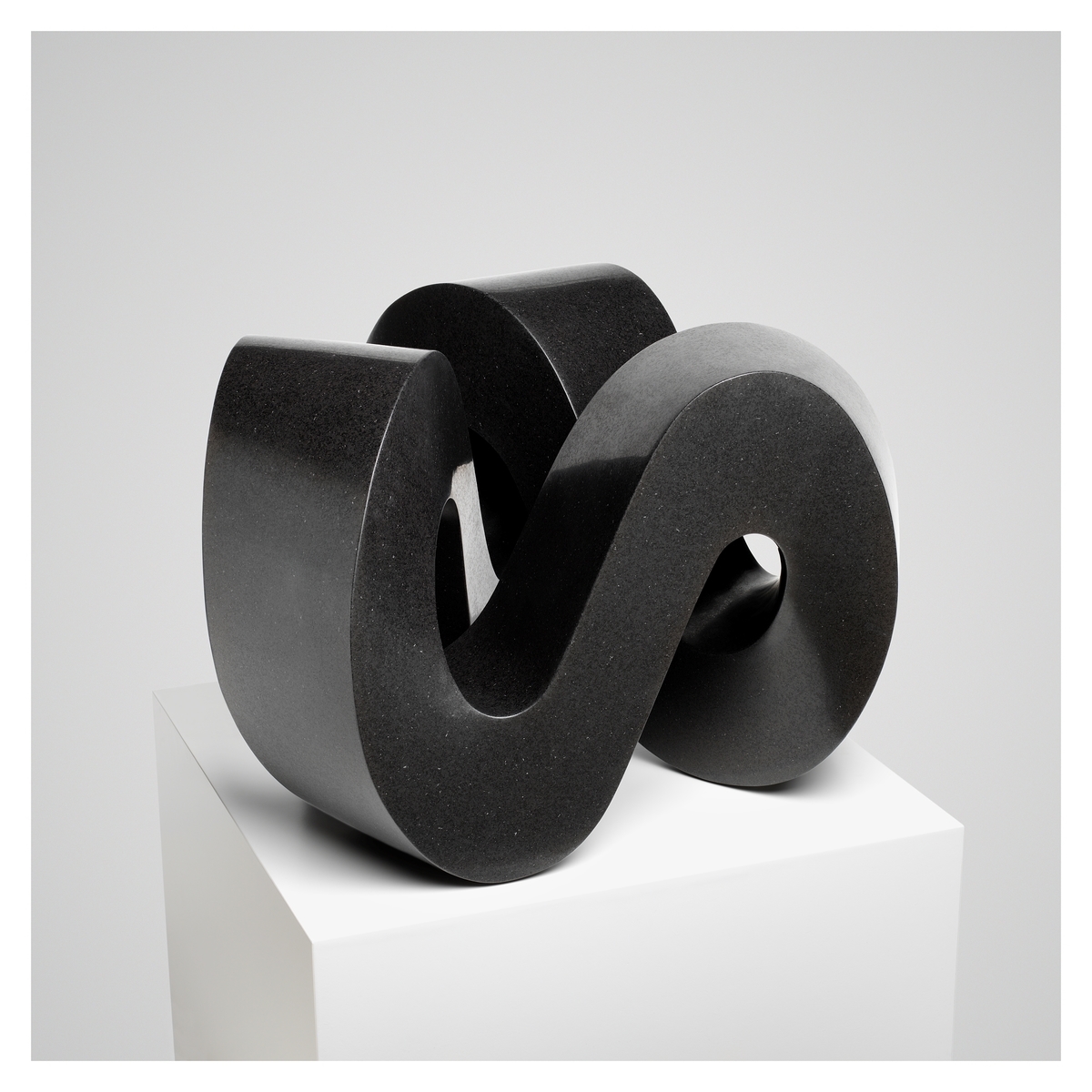
HJ: Of course my biggest criticism would be that I want to see more – more early works specifically. The didactic material briefly mentions the artist’s movement not just towards simplification of form, but away from the human body as the starting point for abstraction and towards mathematical and universal principles as the inspiration for her work. I would very much like to see that idea laid out in the exhibition.
At the same time, I have to be understanding about the scope of exhibition that Sølvberget Galleri has the capacity to produce, and I think the show on view is a tightly curated series of a specific segment of Texmon Rygh’s work. The exhibition focuses primarily on her Mobius or Infinity Sculptures, and although even the number of these works are limited, a visitor can gain a good understanding of Texmon Rygh’s grappling with concepts of infinity and eternity, in short: time. Interestingly, the exhibition text includes a quote from the artist letting visitors know that the viewing, the experience of seeing her artwork, must also be taken in time: “If you want to enjoy my work, you must give yourself time.”
I know that Henie Onstad Art Center had a large-scale exhibition of Texmon Rygh’s work in 1992, and the National Museum in Oslo held a full-scale retrospective in 2014. That said, it might be past time for institutions outside of Norway to consider a full-scale retrospective of her practice.
AHW: It’s also important to note, as I mentioned earlier, that in 2012 she was represented at dOCUMENTA (13) in Kassel, Germany. She was a part of When you step inside it is filled with seeds, a project revolving around notions of art, biodiversity and ecology that was installed at Ottoneum, the Natural History Museum in Kassel. The catalogue The Guidebook published in connection to the exhibition states that Texmon Rygh’s sculptures apply Merleau Ponty’s idea that art is born out of a scheme of contrasts, modulating a crystallization of time, and a possible cipher of transcendence. The catalogue also points to the artist’s statement: “I am working with stories I cannot finish. I start over and over again. I don´t care to find out what stories – perhaps because the result could be more a construction than a sculpture.” This statement points directly to how she conceives of herself as an artist. She has been productive over a long period of time. In that way she is both a modernist and a contemporary artist – her sculptures are timeless. Which is something that is highly relevant because of her many sculptures around the country.
“I am working with stories I cannot finish. I start over and over again. I don´t care to find out what stories – perhaps because the result could be more a construction than a sculpture.”
–Aase Texmon Rygh
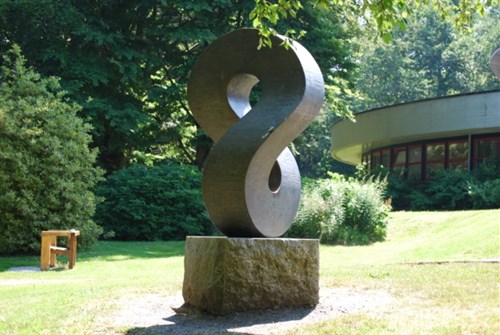
HJ: In Stavanger, many know of her sculpture Mobius Standing, prominently installed in front of Stavanger Kunstmuseum. On several occasions I have admired the sculpture when entering the museum or walking around the lake, without a full understanding of the oeuvre of the artist who created it. In fact, I learned recently that over forty of her sculptures exist in public collections in cities throughout the country including Svolvær, Tromsø, Karasjok, Tønsberg, Moss, Sandvika, Oslo, Haugesund, and Stavanger, among many others. Much like your first encounter with her sculpture on a campus in Oslo, perhaps this is where they most belong – close the public where hands, feet, and the elements are free to interact with a sculpture that has no interior or exterior, beginning or end.


